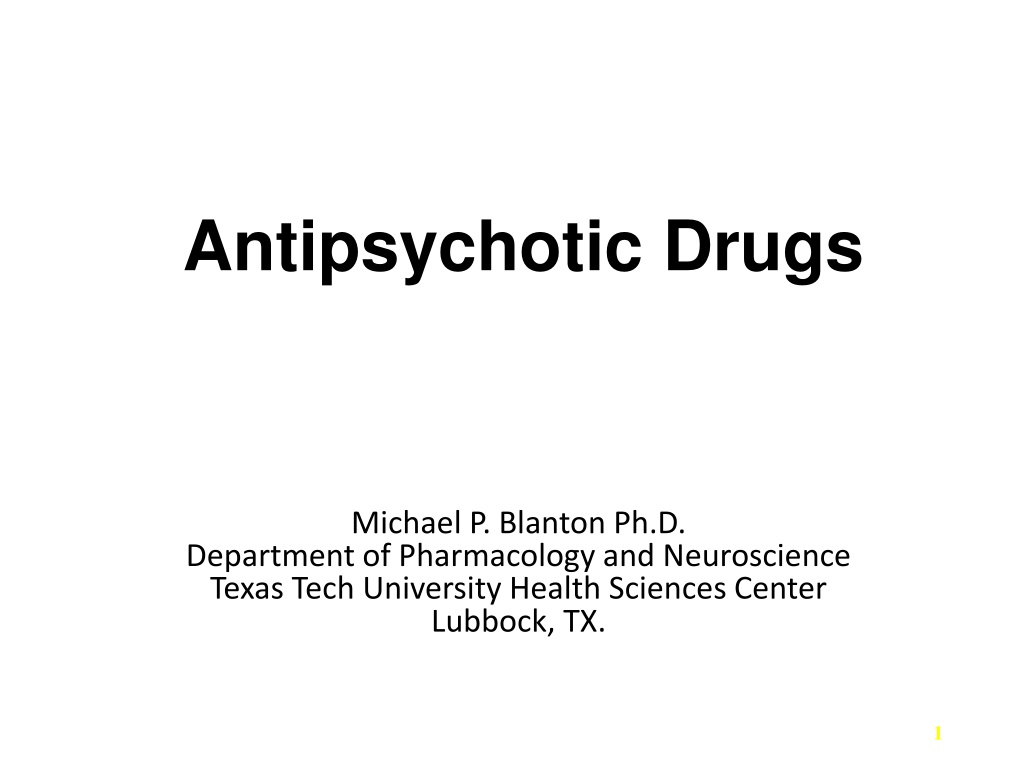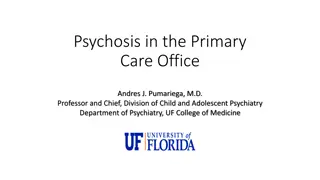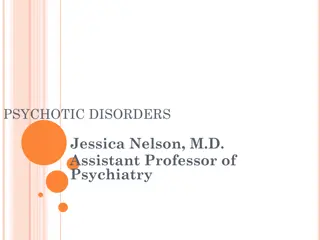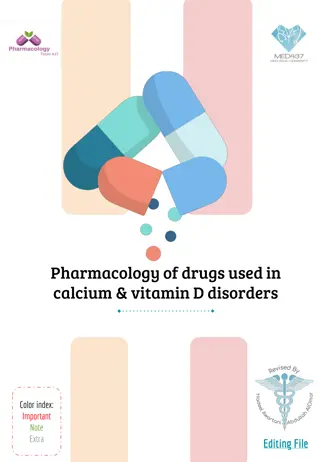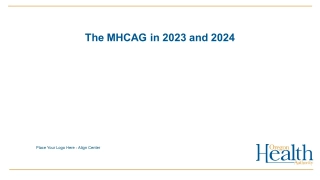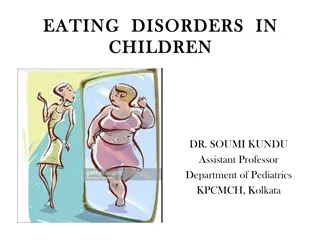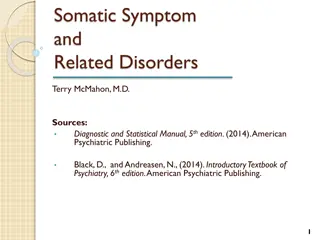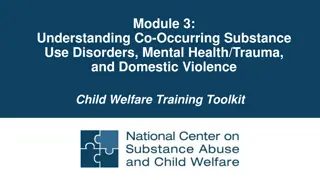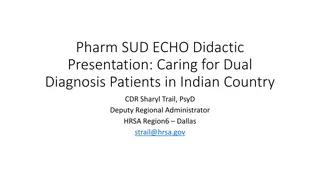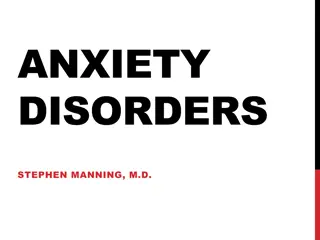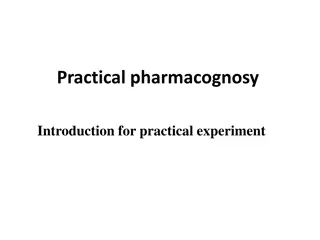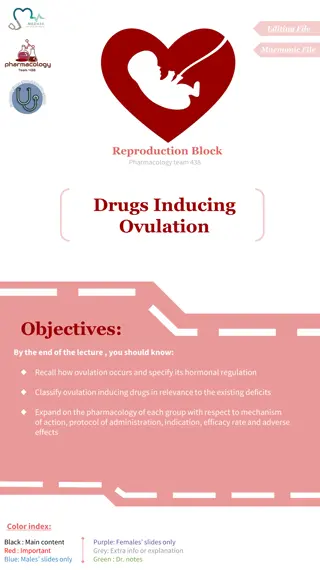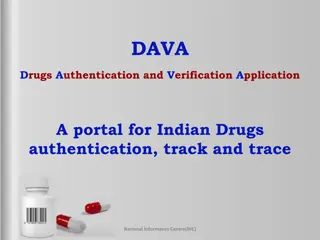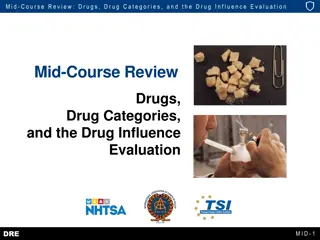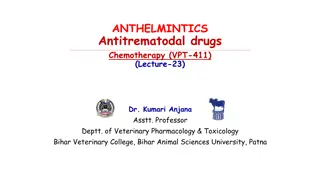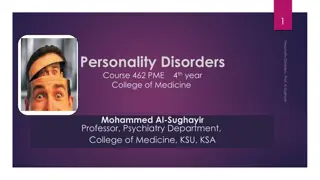Overview of Antipsychotic Drugs and Treatment for Psychotic Disorders
Antipsychotic drugs play a vital role in managing psychotic disorders by targeting dopamine and serotonin receptors. This overview covers the mechanism of action, classification (typical vs. atypical), side effects, and therapeutic efficacy of antipsychotic medications. It also delves into the mood-stabilizing effects of lithium and common mood stabilizers. Understanding the role of neurotransmitters like dopamine and serotonin is crucial in treating symptoms of schizophrenia and other psychotic states.
Download Presentation

Please find below an Image/Link to download the presentation.
The content on the website is provided AS IS for your information and personal use only. It may not be sold, licensed, or shared on other websites without obtaining consent from the author. Download presentation by click this link. If you encounter any issues during the download, it is possible that the publisher has removed the file from their server.
E N D
Presentation Transcript
Antipsychotic Drugs Michael P. Blanton Ph.D. Department of Pharmacology and Neuroscience Texas Tech University Health Sciences Center Lubbock, TX. 1
Antipsychotic Drugs ; Learning Objectives: 1. Discuss role of dopamine and serotonin in the pathophysiology of psychotic disorders. 2. Describe some of the consequences of dopamine blockade, here we will talk about Extrapyramidal Symptoms and Neuroleptic Malignant Syndrome . 3. List drugs used in the treatment of psychotic disorders, grouped as typical (high vs low Potency) and atypical 4. Discuss the mechanism of action, selection and adverse effects of each of the antipsychotic drugs. 5. Compare and contrast differences in typical and atypical antipsychotic drugs. 6. Describe the mood-stabilizing effects of lithium, its low therapeutic index and associated adverse effects and the now commonly used mood-stabilizers, valproic acid and carbamazepine. 2
Psychotic Disorders: Long time theory rests on dopamine driven pathology. It is now clear that multiple receptor/neurotransmitter systems are involved, including both dopamine and serotonergic mechanisms, and likely glutamate receptors are also involved. A simplistic view is that increased dopamine/ serotonin results in psychosis; decreased dopamine/ serotonin results in depression DSM-V: Positive symptoms- delusions, hallucinations, disorganized speech/ thought, catatonic behavior, bizarre behaviors Negative symptoms- (neurovegetative)- flat affect, poor eye contact and lack of goal-directed activity. Most patients exhibit both types of symptoms 3
Antipsychotic Drugs: Other names: neuroleptics, antischizophrenia drugs, antipsychotic, and major tranquilizers)- Used to treat schizophrenia and other psychotic states Side note: Electroconvulsive Therapy (ECT) is a very effective treatment for schizophrenia and other psychotic disorders, but is very expensive and generally reserved for patients that don t respond well to antipsychotic drug treatment. MOA: older neuroleptic drugs Typical Antipsychotics are competitive blockers of dopamine receptors (D2) MOA: newer agents Atypical Antipsychotics are blockers of serotonin receptors (5HT2A) and to a lesser extent dopamine receptors (D2) -The antipsychotic drugs also relieve the manic phase of bipolar affective disorder. -Many also block muscarinic, alpha adrenergic and histamine receptors to a varying degrees -These medications do not cure the underlying disease but they may permit the psychotic patient to function. -All have Equivalent Therapeutic Efficacies. This is certainly the case for treating the positive symptoms, there is some evidence that the atypicals may be slightly more effective in treating the negative symptoms 4
Antipsychotic Drug List: First generation Antipsychotic Agents (Low Potency): Chlorpromazine Prototype Prochlorperizine (Compazine) Thioridazine (Mellaril) First generation Antipsychotic Agents (High Potency): Fluphenazine (Prolixin) Haloperidol (Haldol) Thiothixene (Navane) Miscellaneous Pimozide (Orap) only used for Tourette s Syndrome Second Generation Antipsychotic Agents Atypical : Clozapine (Clozaril ) Risperidone (Resperdal ) Olanzapine ( Zyprexa) Quetiapine (Seroquel) Ziprasidone (Geodone) Aripiprazole (Abilify) 5
Antipsychotic Drug Actions: All reduce positive symptoms hallucinations and agitation by blocking dopamine receptors First generation most effective against positive symptoms. Newer (atypical) agents are arguably more effective in treating negative symptoms The antipsychotic effects take several weeks to be effective Calming effect ( Tranquilizers ) Used to handle agitated and disruptive behavior, parenteral administration for acute agitation Reduce spontaneous physical movement 6
Other actions that can be useful: Antiemetic effect: Due to blockage of D2 in the chemoreceptor trigger zone (CTZ) of the medulla Second generation less effective Anticholinergic effects: Helps minimize the risk of extra pyramidal symptoms (EPS) with first generation Intractable Hiccups: (Chlorpromazine) Pain control: (No Analgesic Effect!) 7
Adverse Effects of Dopamine Blockade Typical >>Atypical: Haloperidol (high potency), Fluphenazine > Thioridazine, Chlorpromazine >> Risperidone, Clozapine 80% show adverse effects but therapeutic index is high Use lowest dose possible Extra Pyramidal Symptoms-(EPS)- dopamine/ acetylcholine imbalance. Akathisia- feeling of restlessness, inability to sit still. Parkinson s Like Disease (bradykinesia (slow moving, tremor, rigidity) Tardive Dyskinesia (TD) stereotyped, repetitive oral facial dyskinesia, choreiform movements of limbs. (May be irreversible ) Agents with higher potency for D2 receptor have greater propensity to induce EPS For agents with high EPS, can use antimuscarinic drugs(blunts excitatory tone). Gynecomastia, amenorrhea and galactorrhea- prolactin release increased with D2 blockade. 8
Adverse Effects of Dopamine Blockade, Neuroleptic Malignant Syndrome: Idiosyncratic (might develop after 2 weeks or 20 years of antipsychotic drug treatment) Rare (0.5-1% receiving high potency neuroleptics) Potentially fatal (mortality rate as high as 20%). Presentation: Stupor, High fever, autonomic instability hypertension, altered pulse rate muscle rigidity, stress leukocytosis (not related to infection), diaphoresis (sweating) elevated creatinine kinase. 9
Other Adverse Effects: Anticholinergic (antimuscarinic): Xerostomia (dry mouth), urinary retention, constipation, Loss of accommodation, aggravation of glaucoma Antiadrenergic ( 1R blockade) : orthostatic hypotension, sexual dysfunction Antihistaminic (H1R blockade): sedation Antiserotonergic: weight gain, more prominent with atypicals Diabetes Mellitus: hyperglycemia, more prominent with atypicals 10
Cautions/Warnings: FDA Black Box not to be used for dementia-related psychosis- increased risk of mortality in elderly dementia patients. May cause drowsiness Avoid alcohol and other depressants Acute agitation with alcohol may be aggravated with neuroleptics benzodiazepines are preferred Do not give to patients with glaucoma or prostatic hypertrophy Caution in CVD or hepatic disease Safety in pregnancy has not been established (Class C) 11
Chlorpromazine (Thorazine) Introduced in 1959, First generation (low potency), antipsychotic Uses: Antipsychotic, control manifestations of mania, intractable hiccups (not used much anymore due to side effects) Highest occurrence of sedation 12
Haloperidol (Haldol) Introduced in 1967, First generation (high potency), antipsychotic Uses: Antipsychotic: Recommended first-line drug for treatment of schizophrenia for treating Acute agitation (rapid acting). Common Extra-Pyramidal-Syndrome (EPS) due to dopamine receptor Blockade and low anticholinergic action. Less drowsiness than other antipsychotics Caution Neuroleptic malignant Syndrome Available as po, im, decanoate (IM depot). 13
Fluphenazine (Prolixin) Introduced in 1959, First generation (high potency), antipsychotic Uses: Antipsychotic: Good in patients refusing oral medications because it comes in depot injection (4 weeks) Available as IM, decanoate (depot). 14
Pimozide (Orap) Miscellaneous category- approved in1985 for Tourette s syndrome Use: Tourette s syndrome used for suppression of motor and phonic tics second line after failure to respond to haloperidol Contraindications: congenital long QT interval syndrome & long history of cardiac arrhythmias 15
Atypical Antipsychotics: Becoming the drugs of choice for treatment of Psychosis High affinity as 5-HT2A (serotonin) receptor antagonists or partial agonists, but also are Dopamine D2receptor antagonists or partial agonists. Bind less avidly to D2 receptors in the striatum and hypothalamus than the conventional antipsychotics therefore produce less EPS and endocrine disturbance. Somewhat better therapeutic profile Appear to improve cognitive function as compared to conventional drugs. 16
Atypical Antipsychotics Clozapine (Clozaril), 1989 Risperidone (Risperdal), 1994 Olanzapine (Zyprexa), 1996 Quetiapine (Seroquel), 1997 Ziprasidone (Geodon), 2001 Aripiprazole (Abilify), 2002 (5-HT2A and D2 receptor partial agonists) Paliperidone (Invega), 2006 Asenapine (Saphris), 2009; Lurasidone (Latuda), 2010; . 18
Atypical Antipsychotics: Clozapine (Clozaril): Use: Antipsychotic (very effective) Excellent for negative symptoms. Low risk for EPS or tardive dyskinesia. Reserved for refractory patients due to High risk for agranulocytosis (can be deadly). Must have weekly CBC. Last resort but Drug of Choice (DOC) for refractive schizophrenia 19
Atypical Antipsychotics: Risperiodone (Risperdal): USE: Antipsychotic with fewer side effects than Clozapine, No agranulocytosis risk. 1st line therapy Paliperidone (Invega) major metabolite Adverse Effects weight gain, orthostatic hypotension and reflex tachycardia at start of treatment Fewer problems with EPS and TD 20
Atypical Antipsychotics: Olanzapine (Zyprexa)* Weight gain is a major problem 30% of patients on olanzapine gain more than 20 pounds. Diabetes can occur Quetiapine (Seroquel)* Less weight gain noted Extra Black Box Warning- Suicidality in Children Diabetes can occur QT prolongation Ziprasidone (Geodon)* No weight gain Diabetes can occur QT prolongation Available as both oral and injectable Aripiprazole (Abilify)* Extra Black Box Warning- Suicidality in Children Weight gain (less weight gain) Diabetes can occur * Low risk for EPS or TD with no agranulocytosis risk. 21
Guidelines for Treatment: Use Atypicals if at all possible. Contraindications include pregnancy, refractory patient and hypersensitivity. Black Box Warning ALL: Not approved for elderly or dementia related psychosis increased mortality (CVD/infections?) Always try to decrease dose needed after acute period. Educate patient and assess compliance. Watch closely for adverse effects. 22
FDA Antipsychotic Drug Labels Requests Diabetes Information on Atypical The FDA has asked drug makers to include information on hyperglycemia and diabetes on the labels of all atypical antipsychotic treatments. According to Eli Lilly, which received an agency letter, the FDA recognizes the relationship between hyperglycemia and antipsychotic drug use is vague and not entirely understood, but believes labeling should reflect medical concerns nonetheless. The drugs affected by the requested labeling change include Lilly's Zyprexa (olanzapine), Pfizer's Geodon (ziprasidone), Bristol-Myers Squibb's Abilify (aripiprazole), AstraZeneca's Seroquel (quetiapine), Novartis' Clozaril (clozapine) and Janssen's Risperdal (risperidone) 23
Bipolar Disorder:(see also Blanton Antidepressant lecture that covers Bipolar Disorders) Since the 1970 slithium carbonate has been the treatment for bipolar disorder. At therapeutic levels, Lithium has a mood-stabilizing effect, hence its value for treating bipolar disorder (~70% of patients respond) The mechanism of action is really not understood yet. Unfortunately the therapeutic window for lithium is very small; the SE include: memory problems, weight gain, tremor, poluria, drowsiness, hypothyroidism, cardiac effects,etc The therapeutic index is 1-2 and acute intoxication can cause vomiting, profuse diarrhea, ataxia, coma, and convulsions. Treatment is mostly supportive and dialysis. 25
Bipolar Disorder Treatment: Because of the low therapeutic index for lithium in recent years there has been increased use of alternative mood-stabilizing agents: these include several of the anticonvulsant agents, including valproic acid, carbamezepine, lamotrignine (the later is only used for maintenance), etc. These anticonvulsants are nearly as effective as lithium and are far safer. How they stabilize mood is not really understood at all. Option 1: Mood Stabilizer (lithium/valproic acid/carbamazepine) +/- .. during depressive phase- add SSRI antidepressant (e.g. fluoxetine) during manic phase- add atypical antipsychotic (e.g. aripiprazole) Option 2: Olanzapine (Pyrexia) + Fluoxetine (Prozac) [combination Symbax].. paradoxical-SSRI combined with 5-HTR blocker? 26
A 40-year-old woman presents with a 6-month history of missed menstrual periods; she describes a milky secretion from her breasts. She is not sexually active. She states that she is on antipsychotics. A pregnancy test is negative and TSH is normal. What medication is she most likely responsible? A. Aripiprazole (Abilify) B. Haloperidol (Haldol) C. Olanzapine (Zyprexa) D. Quetiapine (Seroquel) E. Thioridazine (Mellaril) 0% 0% 0% 0% 0% 2710 A. B. C. D. E.
A 33-year-old woman is brought into the emergency room by ambulance. She has been diagnosed as having schizophrenic disorder, disorganized type, since the age of 17. She has been on antipsychotic medications since that time, which have controlled her symptoms well. Physical examination reveals a well-nourished female with a temperature of 103.2 degrees F, BP of 180/99, HR of 97, and copious perspiration. She is mute, has muscular rigidity, and appears to be obtunded. What is the likely diagnosis? A. B. C. D. Acute dystonia Akathisia Dementia Neuroleptic malignant syndrome Tardive dyskinesia E. 0% 0% 0% 0% 0% A. B. C. D. E. 2810
Patient who has schizophrenia refractive to other medications is put on Thioridazine (Mellaril). Within days, patient complains of severe orthostatic hypotension. What is the mechanism of action responsible for this adverse effect? A. Alpha-1-adrenoceptor blockade B. Dopamine-2 receptor blockade C. Histamine-1 receptor blockade D. Muscarinic receptor blockade E. Serotonin-(5HT-2A) receptor blockade 0% 0% 0% 0% 0% A. B. C. D. E. 2910
Based upon previous vignette, what medication would the patient with refractive schizophrenia ultimately be placed upon, being the only medication known to be effective? A. Aripiprazole (Abilify) B. Clozapine (Clozaril) C. Haloperidol (Haldol) D. Olanzapine (Zyprexa) E. Quetiapine (Seroquel) 0% 0% 0% 0% 0% A. B. C. D. E. 3010
FDA Black Box Warning associated with all antipsychotics (low and high potency - typical and atypical antipsychotics) deals with A. Agranulocytosis/neutro- penia. B. Dementia and increased mortality. C. Diabetes Mellitus. D. Suicidality in young patients. E. Tardive Dyskinesia. 0% 0% 0% 0% 0% A. B. C. D. E. 3110
